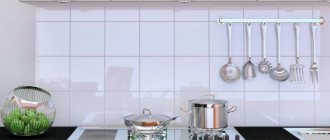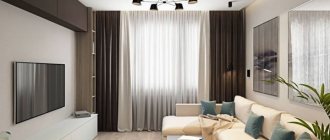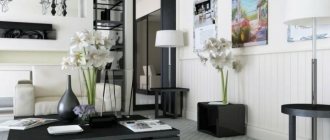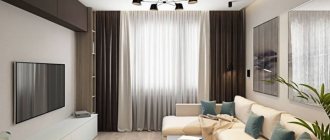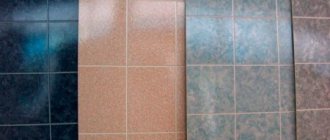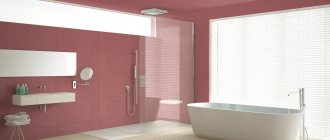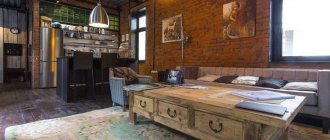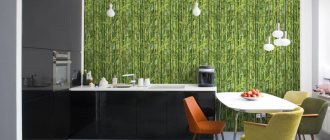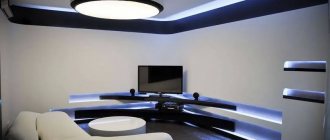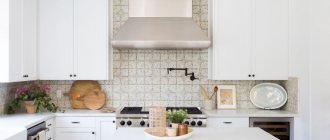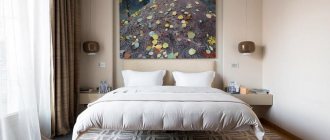Decorative panels are not just a trendy technique for transforming the interior, but also a convenient and practical solution that will help you create a beautiful interior decoration without any problems. Especially if you use 3D panels.
Various variations of design and material help to use it in rooms of any shape, size and purpose - kitchen, bathroom, bedroom.
Types of wall panels
Panels for decorating your home can be selected to suit every taste. Their main difference is the material from which they were made. On this basis they are divided into artificial, natural and combined wall panels. The material can be selected based on your goals and needs.
Natural material panels are made from veneer, solid wood, glass, metal such as aluminum and gypsum. There are also stone panels. They look very beautiful and expensive in the interior.
Artificial panels are made of plastic, PVC (polyvinyl chloride) and PU (polyurethane). They conquer with affordable prices.
By combined we mean wall panels that are made of chipboard (chipboard), laminated chipboard (laminated chipboard) and MDF (medium density fiberboard)
First, let's get acquainted with natural and environmentally friendly materials, and then move on to artificial and combined ones.
Panel designs
What designs are there?
Under the brick
Walls with brick decor created with sheet, tile or slatted panels imitate masonry. There are wooden MDF boards and plastic PVC. They are attached with glue to the wall or to the sheathing.
Under the stone
Stone-look walls look beautiful in the interior and do not take up much space. Lightweight panels made of plastic and gypsum imitate natural limestone, any masonry method and color.
Under the tree
Wood-look walls made of PVC or veneer are suitable for creating comfort and a classic interior. Additionally, they can be varnished for shine.
With relief
Embossed ones made of polyurethane or gypsum create a volume effect on the wall; they are suitable for finishing the central wall of a living room or the wall at the head of the bed.
With an image
Panels with a pattern are additionally protected by an acrylic layer. Highly durable and stable panels are suitable for decorating a nursery with a fairy tale theme, a bathroom with a marine interior, or a kitchen.
The photo shows a teenager's bedroom with wall coverings and a photo print that emphasizes the child's individuality and preferences.
Tree
An excellent solution for those who value the environmental friendliness of the material, but it is worth remembering that wood requires special care so that the panels serve you as long as possible.
This type of coating will look quite organic in country or Provence style interiors. The panels will also look stylish in more modern styles - it all depends on the decor you choose.
Characteristics and scope of application by type of material
We won’t talk about PVC panels. There is a separate article about them with a detailed description of the technology for mounting on walls and ceilings. In this paragraph, we will consider wall panels for interior decoration made from other materials. There are more than enough of them. There are the usual MDF and chipboard, there are exotic bamboo, glass, and metal.
Wall decoration with decorative panels is becoming increasingly popular
Bamboo
Suitable for you if you like ethnic style, for example, Chinese or African. Expensive and rarely found in interiors.
They will perfectly convey the atmosphere of the East in your home if you are a connoisseur of such decor.
Glass
There is no need to be afraid of the fragility of this material, because modern technologies make it possible to produce panels of special strength.
Glass coating has only recently begun to be used for decoration, so it looks unusual and new, especially in minimalist and high-tech interiors.
In addition, glass panels are resistant to moisture or high temperatures, which is ideal for decorating the kitchen area, bathroom and more.
In the kitchen you can use a glass panel with a pattern; some designers use it as an apron.
Panel types
In turn, special panels are divided into several types:
Moisture resistant. They can be used in rooms with high humidity.
We recommend reading:
Original painting of walls in an apartment - cheap and beautiful: photo examples of painting walls- Turquoise walls - design ideas, stylish combinations and design features (130 photos)
- Photo frames on the wall - placement ideas and options for decorating walls using photo frames (115 photos and videos)
Heat resistant. The composition uses fire-resistant impregnations that prevent the material from igniting in a fire. When heated, they smolder, releasing high levels of chemical compounds.
Flexible. They are used to create arched structures. These products are distinguished by their ductility and durability during operation.
High density products. They are designed for the manufacture of structures with increased load.
Mirror
Such panels will help visually expand the room and make it larger. This will also help increase the amount of light in the room.
Due to the fact that the panels are made using different technologies, they can be made on the basis of acrylic, which gives it flexibility, allowing you to decorate even rooms of complex shapes and formats.
Metal
This coating in the interior looks very impressive and unusual. Despite the appearance of a natural metal sheet, it is usually a special film that is applied to some kind of base, such as wood or plastic.
Due to this, the material retains ease of installation, but does not lose its effectiveness.
Soft panels
The current fashion trend for volumetric decor has added to the popularity of soft wall panels. In addition to the aesthetic component, this type of finish has a number of other advantages:
- Easy installation;
- Excellent sound insulation;
- Can be mounted on uneven walls. After installing such panels, all irregularities will be smoothed out by their texture;
- Possibility of using different colors.
Due to the design features, the list of materials for the front part of the panels is limited to three items:
- Genuine Leather. Expensive and stylish material. Such upholstery would be appropriate in official places: conference rooms, restaurants for business meetings, work office;
- Faux leather;
- Textile. Although this is the most budget option, it at the same time provides a wide choice of colors. Fits well into the bedroom interior.
Foam rubber and padding polyester are used for filling. The first allows you to create lush and soft structures, while the second is lighter and does not cake over time. The basis can be a sheet of fiberboard or chipboard.
To secure such a coating to the wall, use sealant for massive decorative items. This is the most popular installation method. The second method is to fasten the panels to the sheathing with self-tapping screws or nails. After completing the installation work, it is necessary to close their caps with plugs.
The main difficulty that you will have to face after installation is attaching additional interior items to the wall: paintings, hangers, sconces, sockets. You can still deal with small elements by attaching them to a soft base, but hanging a heavy shelf or TV bracket will not work so easily. Therefore, it is necessary to prepare in advance for such difficulties by making adjustments to the upholstery plan.
Stone veneer
This material is perfect for you if finances or room features do not allow you to use natural stone, because the distinctive features of stone veneer are light weight, low cost and flexibility.
In addition, the veneer completely replicates not only the appearance of the stone, but also its texture.
Such panels are installed using specialized glue.
Design and principle of operation
Illuminated panels are one of the types of wall decor in which LED lighting is a direct part of the cladding, or is mounted under a material that can transmit light. They themselves can be made from almost any material: gypsum, chipboard, MDF, stone, glass, plastic, metal, leather, wood, etc. Most often, this is a completely ready-to-use finishing material that can simply be fixed in the chosen place. The lamps will require a little more effort during installation, as they require additional wiring, however, if you plan it at the stage of rough repairs, difficulties should not arise.
3D backlit panels for kitchen backsplash
A separate variety is represented by panels with a relief image. Illumination of 3D panels makes the three-dimensional drawing even more expressive, effectively emphasizing the play of volumes and light and shade. Such a wall does not need additional decor, in itself being the highlight of the design.
Important : a 3D drawing can be either a repeating ornament or a finished panel for one plane. The second option is only suitable for an accent wall of a given size.
MDF panels
One of the most popular types of combined panels. The inside of such panels is wood in the form of wood fiber shavings, bonded with paraffin or lignin.
The external coating can be completely different - from paint to laminating film, which can be either with or without a pattern. There are also options with external decor made from valuable tree veneer.
These panels gained popularity due to their interesting properties.
1. Like gypsum panels, MDF is very easy to install because it has new generation joints.
2. Durable.
3. Antifungal impregnation increases the service life and allows the panels to be used even in the bathroom.
4. There is a huge variety of designs and shades that you can choose according to your taste.
5. In addition to impregnation, they are very moisture resistant.
Types of panels for interior decoration
One of the main advantages of wall panels is the large selection of models made from different materials and with different appearances. This makes it possible to use an inexpensive finishing option even for modern design projects. Let's take a closer look at what types of wall panels exist, what their features are, and in what cases it is best to use them.
Some types of panels are made to imitate various natural materials: stone or brickwork, wood. These types include PVC, MDF, gypsum boards.
PVC panels
Plastic panels are perhaps the most popular option for quick and inexpensive finishing. They are used for non-residential and residential premises. Of course, such material is not suitable for a bedroom or kitchen, but it is just right for finishing a balcony, corridor, or bathroom.
Advantages of plastic panels:
- durability;
- moisture resistance;
- ease of installation;
- environmental friendliness;
- low cost.
Such panels can imitate any surface - stone, brick, wood. The color palette of most manufacturers is also wide.
One of the disadvantages is that over time the paint of such material can fade. This is especially true for panels that are constantly exposed to direct sunlight - on a balcony or loggia, veranda.
It is worth clarifying that there are several types of plastic panels: lining, panels themselves, sheets. Each of them is used in accordance with the characteristics of the room.
PVC lining 10x100x3000
Current prices for your city:
MDF panels
MDF is a board made from wood chips pressed under high temperatures. A special manufacturing technology helps eliminate some toxic substances such as phenol and epoxy resin from the material. This means that MDF panels can be used even in residential premises.
Decorating the hallway with MDF panels
Lamination adds aesthetic appeal to such panels. Most often, the film pattern imitates the structure of natural wood or stone, but some manufacturers also have more original color options.
Wood-effect MDF wall panels
Advantages of MDF panels:
- strength and durability;
- moisture resistance;
- ease of care;
- relatively low cost;
- ease of installation.
Chipboard
They are made from wood chips and are very cheap. Like many types of panels, sound insulation can be added.
One of the most significant disadvantages is the harmful and not environmentally friendly composition, as well as susceptibility to deterioration from steam, moisture or mechanical stress. In addition, such panels are quite heavy, so installing them will not be easy.
How to decorate a kitchen with PVC panels
You can try to use plastic in decoration so that it looks organic and does not “cheap” the room.
Take a closer look at the plastic lining. At first glance, high-quality, textured “planks” imitating wood cannot be distinguished from real ones. White plain lining under bleached pine needles can be used to decorate the walls and ceiling - selectively or completely. In order not to overload the space with plastic, although indistinguishable from wood, you can allocate separate zones for it - at the dining table, in the work area near the headset, an apron. And on the ceiling, imitation wood paneling will be an interesting alternative to stretch fabric. It is better to take textured lamellas that are rough to the touch. Laying boards horizontally on the walls will expand and lengthen the room, while laying them vertically will stretch it upward.
Unsplash
Instagram @finerspaces_kelly
Drawings rarely look good. It is still lifes and seascapes on the walls or apron that simplify the interior as much as possible. To decorate a kitchen backsplash with a PVC panel, you can use imitation brick. An apron made of white bricks, which are visually indistinguishable from the classic “hog” tiles, will look good.
Instagram @kimmyrae_
Instagram @mamochka_kate
Unsplash
A wall with a marble pattern will look stylish. In a light, minimalist interior, such an apron looks appropriate, especially in combination with a suitable countertop.
Instagram @designedbycourtney
Pixabay
Like plastic bricks, PVC mosaic is an original solution for decorating the cooking area. It is better to stick to monochrome and not choose bright unnatural colors; white, beige, gray, ivory are ideal. Between matte and glossy, it is better to choose matte. This surface looks more natural. You can experiment with gloss in a high-tech or minimalist interior, but it is better not to make a “mirror” wall in this area.
Unsplash
Pixabay
Between lining and sheets, it is better to choose the first. It is extremely difficult to find sheets with a suitable texture so that they do not look like a piece of plastic glued to the wall.
Panels or soft panels made of artificial leather or textiles
The variety of variations of soft panels will allow you to realize your dream design. Stylish options can be found at low cost. The variety of available textures will help you make unusual combinations.
Such panels will help you out if you have problem walls or if you want to hide wiring, irregularities, or disguise drywall joints.
With the help of this design, you can create a special coziness in a bedroom or nursery, because with such panels you can stylishly decorate the headboard or create a “safe zone” - a shock-proof barrier.
And as a nice addition - sound insulation and thermal insulation.
Where to use in decoration
Wall panels in the interior can perform a variety of tasks: from a decorative function to hiding wiring, various wall defects, insulation, and soundproofing a room. If everything is simple with the practical side of things, then with the decor everything is much more complicated. There are several methods for distributing panels on the wall plane that will help achieve maximum aesthetic effect:
- Only part of the wall. The traditional technique is when the panels are attached to the bottom of the wall. At the same time, try to maintain a proportion of 1:3, i.e. they should be located no higher than the lower third of the wall. This will create the effect of high ceilings. Well suited for the living room, corridor, hallway, nursery, kitchen, bathroom;
- All over the wall. This option is a classic and emphasizes the status of the room. It is better to avoid using it for very small rooms with low ceilings, since the design will make the room feel heavier. You should not resort to this technique in the rooms where you spend most of your time. Wooden panels would be most appropriate here. Suitable for library, billiard room.
- Emphasis on decor. With this option, you select a specific section of the wall or several intervals to decorate with panels. In this case, you do not need to tie the height of furniture and decorative items to a certain value, as in the very first technique. Here you will not burden the space in any way if you arrange all the interior items correctly. It will look good in the bedroom, living room, hallway.
And don’t forget - the final choice is always yours!
PVC
They will help you make a coating to look like natural stone or wood at a low and affordable cost.
PVC panels are very diverse in shades and textures, which will help you realize all your design fantasies at a low price.
Types of panels
To date, several options for finishing materials have been developed. These include:
Regular. They are made from solid pressed sawdust. Finished products are long panels no more than 5 mm thick. The surface of such products is not treated with anything. To add color, tints are used.
Special. In this case, high-quality wood is used. It is crushed to a fine fraction and pressed in compliance with the temperature regime. Finished products are distinguished by their durability and interesting texture.
Polyurethane
Despite the obvious non-ecological friendliness of the material, they are distinguished by useful practical properties, for example, resistance to damage. The panels are very light, which makes installation easy. In the interior they are used not only for walls, but also for ceiling decoration.
Such panels are suitable for you if you have a non-standard room, because this material easily takes different shapes, unlike the same plaster.
Polyurethane has poor thermal conductivity, which can be considered both a plus and a minus, depending on the climate in which you live. This feature will work to your advantage if you live in a cold region - this material will allow you to keep warm in the apartment.
Separation of wall panels by material of manufacture
Modern wall panels are made from various types of materials - from natural wood to plastic. To reduce the cost of products, manufacturers most often use a combination of different materials. But on the wide market you can also find panels made exclusively from natural raw materials - wood or glass, for example. Of course, for the high environmental friendliness of the product you will need to pay higher than the average market price of wall finishing panels. But the naturalness of materials determines not only the magnificent aesthetics of the finish. But also the health and well-being of everyone present in the room.
Natural wood wall panels
If you want to create an atmosphere that is not only aesthetically pleasing, but also safe for humans and the environment, then it makes sense for you to consider using wood wall panels. The natural warmth that natural wood brings into the interior of a room will be the key to creating a comfortable, safe, but at the same time functional environment. Most often, wall panels are made from the following types of wood:
- linden;
- oak;
- maple;
- cedar;
- bamboo
As a rule, wall panels made of natural wood are made in the form of tiles or slats; it is not easy to find a sheet type of this finishing material. The only exception is mosaic panels, which are based on fiberboard, onto which pieces of wood of various species are glued (the difference in color and texture allows you to create truly original compositions).
In addition to the undeniable advantages of a high level of aesthetics and environmental friendliness, wood wall panels also have their disadvantages. Considering the ability of wood to absorb moisture and promote the spread of fungus, panels made of natural material cannot be used in rooms with high humidity (bathroom, laundry room, kitchen splashback area). If the panels are coated with protective varnishes or even painted, the level of resistance to moisture will certainly increase, but the natural grain of the wood will change and the environmental friendliness of the room’s finishing will significantly decrease.
Chipboard wall panels
To put it simply, chipboard panels are made from wood processing waste. Hence the availability and low cost. Despite the fact that chipboard is significantly inferior to natural wood, its affordable price makes this material the most attractive for the majority of our compatriots. Despite the fact that the production of chipboard uses adhesives that are quite harmful to humans and the environment, this material is very widely used both in construction and in the decoration of residential premises.
Uncoated chipboard panels are usually not used - their appearance leaves much to be desired. The use of plastic coating of various colors and textures allows you to create interesting options for finishing materials, imitation stone and wood.
Chipboard wall panels are available only in a tiled version. Sheet modification would be impossible due to the large weight of the products and the complexity of installing the finished sheet. Panels for finishing walls made of chipboard are not used for finishing rooms with high humidity and temperature changes.
Finishing using fiberboard panels
Fibreboard panels are produced by pressing wood fibers under high pressure. Fiberboard panels are the absolute leader in their segment of finishing materials in our country. Along with an affordable price, the products have excellent technological qualities. Thanks to modern technologies and the use of natural raw materials, it is possible to achieve a wide range of color variations and images of the natural pattern of wood. Fiberboard material is an organic mix of natural warmth and the dynamics of modern technologies.
Fiberboard wall panels can be mounted either on the sheathing or directly on the wall (only previously dropped, cleaned and dried). The products are connected to each other using grooves or a locking method. This is another clear advantage of slatted or tile panels made of fiberboard - a damaged product can be replaced without getting rid of the entire finish.
The disadvantages of the material for the production of wall panels include low moisture resistance. This finishing material cannot be used for covering rooms such as a bathroom, toilet (in the hallway you should also not create finishing in an area of increased risk of moisture and pollution - at the entrance to the home).
Most often, fiberboard acts only as a basis for creating panels. The top of the product can be covered with fabric, leather, or treated with wood, glass or ceramic mosaic. But the most common option is the use of lamination to create original colors and various imitations.
Wall covering with MDF panels
If we compare MDF panels with fiberboard material, they are not as dense, which means they have less weight and are suitable for installation on any surface. A distinctive feature of MDF wall panels is their excellent sound and heat insulation properties. MDF panels are quite versatile - during the production process they can be made moisture-resistant, fire-resistant, and resistant to the occurrence and spread of fungus. Obviously, such technological improvements also entail an increase in the cost of finishing materials.
PVC wall panels
PVC panels are a popular type of finishing for rooms with a wide variety of purposes. High moisture resistance, resistance to mechanical stress, ease of installation, relative cheapness and sufficient service life of such a finish make it attractive to most of our compatriots.
PVC panels can be manufactured in all three modifications - sheet, slatted and tile. Products with a base made of fiberboard or MDF coated with PVC film can imitate natural materials - wood, stone or brickwork. Significant disadvantages of PVC material include its artificial origin, which means low environmental friendliness of the finish.
Wall decoration with gypsum vinyl panels
Imagine sheets of plasterboard (a material familiar to everyone for covering walls and ceilings, creating niches and other structural elements), but covered with a layer of vinyl. Unlike gypsum board, gypsum vinyl panels are already ready to create the final finish - their surface has a pattern or plain coloring (the range of colors is incredibly wide).
Not so long ago, gypsum vinyl panels were used mainly for the decoration of office and public premises. Currently, this material, which is stronger than plasterboard, is also used for cladding walls in residential spaces.
Relief panels or 3D wall decoration
Embossed wall panels can be classified as a separate category of original solutions for creating reliable finishing. As a rule, the basis for such products is fiberboard or MDF, the relief layer is most often created from gypsum, and the top is covered with PVC film. Sometimes wood or metal reinforcement is used to make a 3D layer, but the cost of such panels will be significantly higher than those made from gypsum.
Most often, relief panels for wall decoration are presented in the form of sheets, less often in the form of large tiles. In any case, finishing with panels with a pronounced texture allows you to create original images of rooms and bring creativity to the interior.
Textile or leather panels in a modern interior
Soft panels are most often used to decorate bedrooms, children's rooms, and sometimes to create an accent wall in the living room. Excellent sound insulation, environmental friendliness and original appearance are what captivate our compatriots to use textiles or leather to decorate all or accent walls in their homes.
If you decide to purchase wall panels coated with leather, then pay attention to artificial analogues - they are much cheaper than natural material, and outwardly have similar aesthetic properties. Soft faux leather panels are easy to care for and incredibly practical - they withstand moisture, do not fade in the sun, and can be cleaned with a damp sponge and wiped dry to achieve perfect cleanliness.
And in conclusion
Experts do not recommend purchasing finishing material in the form of panels online, unless there is no other option. Before purchasing, you need to familiarize yourself with the quality of the products, check the labeling, make sure the material is safe and non-toxic by studying the certificates of conformity:
- check the following indicators on the panel label: flammability, flammability, smoke generation and toxicity (the higher the class, the worse - from 1 to 4);
- purchase panels from the same batch - shades may differ (batch number on the package label);
- check the integrity of the products themselves and the locking connections or puzzles (stores very rarely replace bark products after completing the purchase).
3D panels
Such panels can be made from natural, artificial or combined materials. In design, 3D panels look much more expensive than the real cost and help realize even the wildest fantasies and projects.
Nowadays such coatings are very popular and are at the peak of fashion.
Basic concepts of installing panels yourself
First you need to acquire auxiliary tools, namely:
- wood hacksaw,
- drill,
- a screwdriver is much more convenient than a screwdriver,
- scissors to cut metal,
- hammer,
- building level,
- roulette,
- stepladder.
Walls are finished with wall panels only after the surface is leveled and cleaned of paint and dust. First you need to measure the area where the coating will then be installed.
Start installing the system when all the fittings have already been attached - internal and external corners and ceiling plinth.
Installation of panels in a horizontal manner occurs from the very bottom to the top. The slabs are fixed with self-tapping screws, nails or special glue.
If there is a need to change the dimensions of the slab, then use scissors or a hacksaw.
Look also here:
- Electrical panel in a private house
- 3 types of floor slabs
What determines the cost of a plastic window?
Wall decoration with panels allows you to implement any design of your home. Relying on your own taste and imagination, you can get a rather fashionable interior.
Slatted panels
Such panels are made not necessarily from wood, but also from plastic. If wood is used, it is usually subjected to special treatment - varnish, stain or paint. This approach helps make the wood shiny and durable.
The panels have a tongue-and-groove fastening system, in which the joints are closed with special corners. This allows you to make the composition unified and disguise the transitions between the slats, which, by the way, do not have to have the same length, width and thickness.
Also, with the help of such panels you can work with the geometry of the room, for example, expand the space using horizontal lines or visually raise the ceiling using vertical lines.
Installation work
Before installing the panels, specialists prepare the working plane. They make cornices from thin wooden slats. For strong fixation, install several rows.
During installation work, there are no seams or cracks. The panels are tightly fixed to each other. The thickness of wooden materials should not exceed 10 cm.
- Stamp ink for seals and stamps
- Insulation of the house. Requirements for thermal insulation material
Is the price of a window the price of peace and comfort?
The distance from the wall to the panels is 8 cm. The main requirement of such structures is good ventilation. If there is insufficient movement of air masses, excess dampness may appear.
After installing the main panels, move on to the ceiling area. Special skirting boards are attached here to help complete the composition.
Sheet panels
Despite their large size, unlike the same slats, they are installed quite simply through the use of glue, the selection of which depends on the composition of the panel, and the seams can be easily hidden using moldings.
Most often they are made to resemble some natural material, such as stone, or to resemble brickwork. In the production of such panels, artificial material is usually used, for example, PVC (polyvinyl chloride).
Advantages and disadvantages of PVC panels
These building materials have a number of advantages. Experts say that thanks to PVC panels, many designers manage to create exclusive interior designs. The positive qualities of the panels include:
- masking any wall imperfections;
- realistic image;
- ease of installation work;
- zoning of the premises;
- visual expansion of the living space.
The disadvantages include harmful chemical compounds included in the products.
Recommendations for choosing panels
1. Initially check the integrity and quality of the finishing material in the store. This will save you nerves and money.
2. Don’t forget about the room you are choosing panels for. For example, in the bathroom it would be more appropriate to place moisture-resistant materials.
3. Also remember the size of the room. If you have a small room, then with the help of mirror panels you can expand it and make it brighter.
4. Study the labels. Pay special attention to SNiP, namely the indicators of toxicity, flammability, flammability, and smoke formation. For ideal panels these indicators are equal to 1.
Classification of wall panels
Wall panels differ in color, texture, size, mounting method and shape. The image of the created interior largely depends on what type of wall panels you choose for finishing. So, according to their shape, all wall panels can be divided into three classes:
- rack and pinion;
- tiled;
- leafy.
Let's take a closer look at each type of wall panels.
Slatted panels
Slatted or typesetting panels are narrow (no more than 30 cm) slats about 2.5 - 3.5 m long and no more than a centimeter thick, which can be attached to walls both horizontally and vertically. Slatted panels are an ideal type of finishing for small rooms or rooms with complex geometry (for example, in attic spaces with many corners, slopes and niches).
In order to cover the walls with slatted panels, it will be necessary to first create a metal or wooden frame of the so-called sheathing. The sheathing panels are connected to the frame using special fasteners - staples (a construction stapler is used) or self-tapping screws (a drill is useful). You can carry out this type of finishing yourself, if you have some skill in working with tools.
Slat panels can be made from the following materials:
- MDF;
- Fibreboard, chipboard;
- PVC.
As a rule, typesetting panels are sold with components and fittings that are necessary for decorating joints, corners and other structural elements of the room to create a finished image.
Tile panels
This type of panel is made in the shape of a square or slightly elongated rectangle. The square side of such products can have a size from 30 to 100 cm. This type of wall panels is mounted using glue or special fasteners - clamps. The main advantage of this type of panels is the ease of installation and the ability to create a finish with virtually no seams - the products are fastened by connecting grooves and inserts.
Tile panels are one of the most popular types of this type of finishing materials. Buyers are attracted not only by the rich color range and the opportunity to purchase products from both natural and artificial materials, but also by the choice of the optimal size of panels, which will reduce the consumption of raw materials and the amount of waste to a minimum.
Sheet panels
The name of the panels speaks for itself - this is the largest type of finishing material in size, which is a canvas made from natural or artificial raw materials. Sheet panels help create a seamless finish on small surfaces or cover as many walls as possible with the least amount of labor.
Sheet panels are multilayer sheets based on MDF, ZhVP or PVC with a printed pattern (imitation of wood, stone or any other surfaces) and texture. Sheet panels are most often used to create an accent surface, but they can also be used in combination with other finishing materials for all walls of the room.
